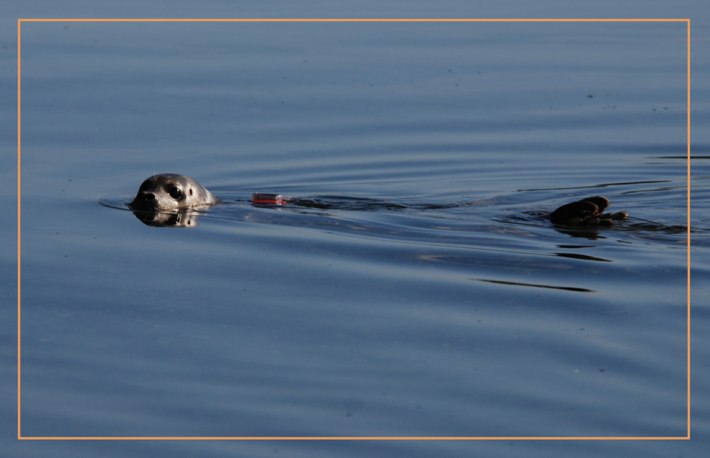
Every summer, dozens of stranded baby harbor seals are brought to centers where they’re rehabilitated and released back into the wild. People expect these animals will behave like wild seals. But do they?
To find out, SeaDoc and colleagues satellite-tagged and tracked 20 harbor seal pups – half rehabilitated, half naturally weaned. The differences were big. Rehabilitated seal pups took off like torpedoes after release, traveling three times farther daily and dispersing three times as widely as the wild ones. And the rehabbed pups only transmitted signals for half as long as their wild cohorts, which could relate to how long they survived.
What’s extra fascinating here is that we’re talking about a mammal that spends just a single month nursing before it’s left on its own to survive. But if human-reared pups are traveling so much further, it could mean that wild pups actually learn quite a bit about foraging in the short time they spend flippering alongside their mothers, even if they’re only nursing and not catching fish. It could also mean that wild pups “imprint” on a local area during their first month. Or it might mean that rehabbed pups are naive to navigating the strong currents that sweep through the San Juans. It is time to learn how best to enhance rehabilitation techniques to get pups behaving more like wild seal pups after release.
More Information:
![]() SeaDoc's paper was written by Joe Gaydos and Ignacio Vilchis of the SeaDoc Society (UC Davis), Monique Lance and Steven Jeffries of the Washington Dept. of Fish and Wildlife, Austen Thomas of the University of British Columbia, Vanessa Greenwood and Penny Harner of Wolf Hollow Rehabilitation Center, and Michael Ziccardi of the Wildlife Health Center at UC Davis.
SeaDoc's paper was written by Joe Gaydos and Ignacio Vilchis of the SeaDoc Society (UC Davis), Monique Lance and Steven Jeffries of the Washington Dept. of Fish and Wildlife, Austen Thomas of the University of British Columbia, Vanessa Greenwood and Penny Harner of Wolf Hollow Rehabilitation Center, and Michael Ziccardi of the Wildlife Health Center at UC Davis.
The abstract is here. If you would like a copy of the full manuscript please email your request to seadoc@seadocsociety.org.
This study was funded by NOAA's John H. Prescott Marine Mammal Rescue Assistance Grant Program and private donations from SeaDoc supporters, including a significant donation from Bill and Lannie Hoglund. For this particular study, the private donations were a critical part of the mix because the Prescott funds could not be used to study wild-weaned seals.
Overview of post-rehabilitation research:
At the 2012 North American Veterinary Conference, Joe Gaydos gave an overview of the need for post-rehabilitation studies and reviewed the studies performed to date. He also discussed the role of veterinarians in marine mammal rehabilitation. Read the PDF.
Stranded seal recovery:
Stranded seals are generally found in the summer months. There are a number of reasons why pups become separated from their mothers, including illness, interference from dogs and humans, and maternal death. SeaDoc's summer interns assist with the Marine Mammal Stranding Network in the San Juan Islands. They often provide first-line veterinary response when pups are picked up and transported to the rehab center.
Wild seal capture:
The wild-weaned seals were captured by the investigation team from a haulout location in the San Juan Islands.
Keep your distance from marine mammals:
We always like to remind people that Federal law requires everyone to stay at least 100 meters away from marine mammals like Harbor Seals. Do not approach pups you think are stranded or abandoned. They may be just waiting for their mother to return, but if you approach you may scare off the mother and cause the pup to be abandoned.
Harbor Seal facts:
Did you know the milk of harbor seals is 40% fat? Or that they can dive up to 600 feet? View more harbor seal facts.
Harbor Seal skeleton available for display:
SeaDoc has a mounted skeleton of a large male harbor seal found dead on a beach in San Juan County. The skeleton travels to schools, banks, and other public display locations to help people learn about Salish Sea marine mammals. If you're interested in displaying the skeleton at your place of business, get in touch. See pictures.
Surprise your friends with a Harbor Seal ringtone:
Just for fun, we took a recording of a squawking young seal and turned it into a ringtone for the iPhone. It sounds a little bit like a badly out-of-sorts child, and definitely gets some strange looks in the grocery store. Details.
